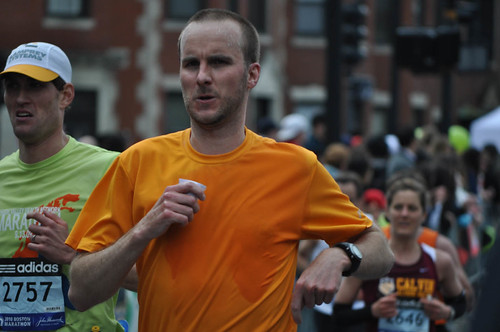Running When Hot: Three Simple Ways To Beat the Heat

Dealing with high temperatures and humidity on marathon race day is a critical success factor:. If you can’t or don’t know how to do it, your day could end prematurely and most likely your finishing time will fall far outside of your goal window.
That said, many runners are affected by the heat long before they reach the starting line. Simply based on where they live and the time of year, these folks spend the majority of their marathon training schedule attempting to avoid the performance killing effects of high temps. You might be envious of their race performances in the heat, but know that they have been suffering for much longer than 26.2 miles.
Hot vs Hard
Increased heat means a distorted sense of perceived exertion (my easy pace feels really hard!) and an increased heart rate (your body is working double time to keep cool and keep moving). But while your overall performance deteriorates when temps are above an “optimal” range, your muscles aren’t working any harder just because it’s hot. In fact, the opposite is true: the slower you run, the less stress you are placing on your running-specific muscles.
Less stress means less work, and ultimately less adaptation. To put it another way, it’s like being able to bench press 100lbs, but on really hot days you only put 85lbs on the bar because it feels harder. Inside MN, our focus is on quality, not quantity, and so we need to solve for this heat if the training is to work. So how do you continue to keep the pressure on your body to see progress, yet avoid overtraining?
Suggestions
Here are three ideas you can use to adjust your workouts to compensate for the heat. Whatever you do, don’t train yourself so hard you earn a free hospital journey — it’s just not worth it!
#1 — Run in the early morning. The temps are not as hot and the air quality is pretty good. This is your best bet if your schedule allows for it.
#2 — Run slightly further because you’ll be going slower pace for a given effort / heart rate. If you wanted to run 7 miles at 9:00 pace, but you can only muster 9:30s or 9:45s, then extend your run to 8 or 8.5 miles. Just make sure you have means to stay hydrated and stay protected in the sun!
#3 — Adjust the intervals of your harder runs in order to continue running at your normal paces. You can do this by:
- Running shorter work intervals. Do 6 x 2.5 minutes instead of 3 x 5 minutes;
- Taking longer recoveries between work intervals so as to be ready for the next work piece; or
- Splitting tempo runs into intervals. Make that 6 mile tempo run into 3 x 2 miles or 2 x 3 miles with breaks in the middle to hydrate properly and get cool.
Conclusion
Regardless of which option you chose for your particular workout (or entire training cycle), adapting how you train based on the conditions in which you have to train is critical. You can only ignore the realities of heat and its affect on your body and ability to run for so long; learn to bend like a reed or face the consequences!
Thanks again for reading our blog. Your comments and feedback are not only welcome, they help make what we do better! Please add your input below, who knows your special secret might just help somebody else! Thanks! ~ Patrick

2 Responses to “Running When Hot: Three Simple Ways To Beat the Heat”